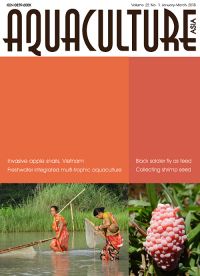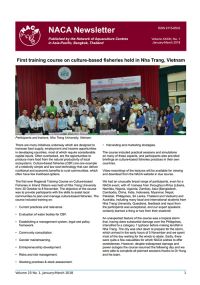In this issue:
Invasive apple snails (Pomacea spp.) in Vietnam: Short review; A review of fresh water integrated multi-trophic aquaculture: Catching up on the dream of a blue revolution in India; Pre-pupae (larvae) of black soldier fly - a potential alternate protein source for aquaculture feeds; Penaeid shrimp and giant prawn seed collection from Rupnarayan River in Purba Medinipur, West Bengal, India; NACA Newsletter; First training course on culture-based fisheries held in Nha Trang, Vietnam.
In this issue:
First training course on culture-based fisheries held in Nha Trang, Vietnam; GAF7: Gender in Aquaculture and Fisheries; 3rd International Symposium on Aquaculture and Fisheries Education, India; International Fishing Industry Safety and Health Conference, Canada; WHO: Stop using antibiotics in healthy animals to prevent the spread of antibiotic resistance; Register for the 8th International Symposium on Aquatic Animal Health; Quarterly Aquatic Animal Disease Report, July-September 2017; Biology and Management of Invasive Apple Snails; Antimicrobial use in the aquaculture sector.
The 3rd International Symposium on Aquaculture and Fisheries Education (ISAFE3), a triennial event of the Asian Fisheries Society (AFS), will be held from 16-18 May 2018 in Mumbai, India. The theme of the symposium is "Fisheries education for Sustainable Blue Economy. The symposium is being organised by the ICAR-Central Institute of Fisheries Education in collaboration with the Indian Fisheries Association and AFS Indian Branch. Online registration is now open. Abstract submission will close on 31 March.
Organizers of the 8th International Symposium on Aquatic Animal Health have opened registrations and called for abstract submissions for oral and poster presentations. The 2018 symposium marks the thirtieth anniversary of the ISAAH, which will be held September 2 – 6, 2018 in Prince Edward Island, Canada. Early Bird registration rates are available now, and, as there are limited spaces for registered delegates to attend the pre-conference scientific workshops, organizers encourage participants to sign up as soon as possible.
This collection contains video recordings of the lectures from the Regional Training Course on Culture-based Fisheries in Inland Waters, held at Nha Trang University, Vietnam. The objective of the course was to provide participants with the skills to assist local communities to plan and manage culture-based fisheries; a relatively simple and low cost technology that can deliver nutritional and economic benefits to rural communities with few livelihood options. The course was sponsored by the United Nations University Fisheries Training Programme.


